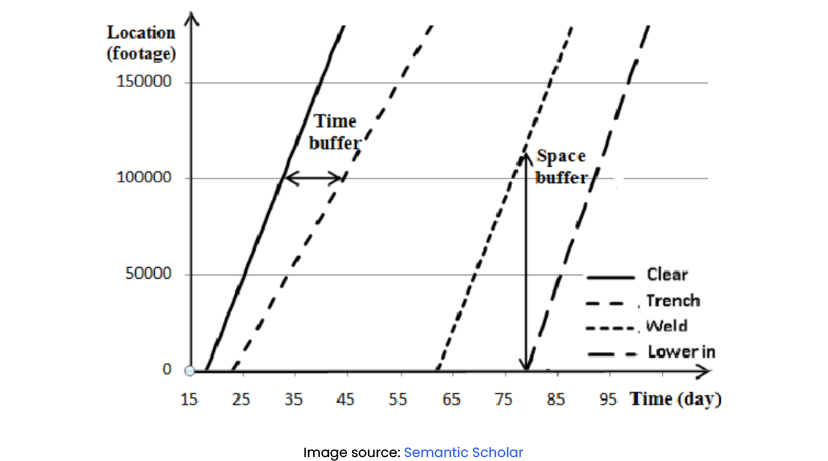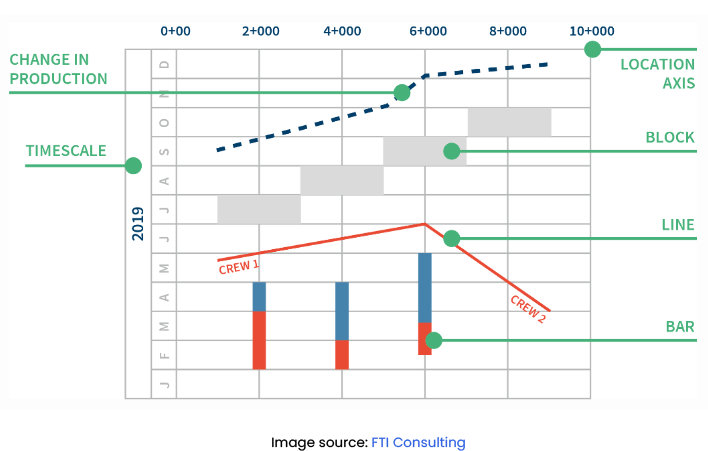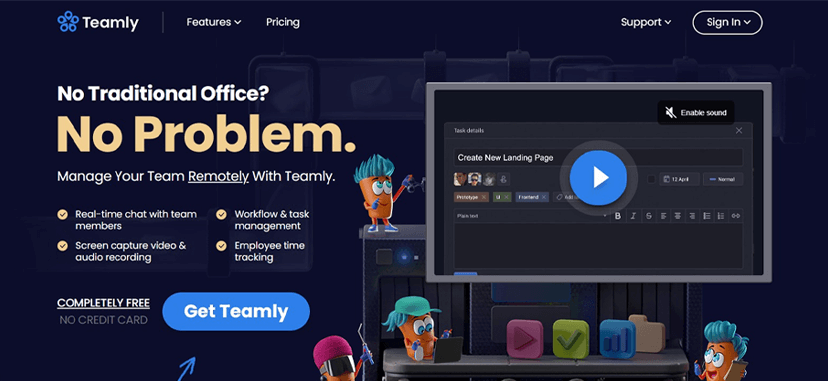
Click the button to start reading
The ABCs of Linear Scheduling (+ Pros, Cons, and Steps for Success)
Suppose you’re building a brand-new playground. Now, building this playground involves a lot of steps. Laying the foundation, putting up the swings, setting up the slides, and adding all the fun stuff.
But you can’t just do everything all at once, right?
That’s where the linear scheduling method comes in. When you have a super organized to-do list, project coordination becomes a breeze.
In this article, we’ll define linear scheduling and use examples to explain what the linear scheduling method is all about. As we move on, we’ll share the key pros and cons of linear scheduling to help you make the best choice. Finally, you’ll get an example of linear scheduling software to take your project management game to the next level.
Let’s dive in.
What Is Linear Scheduling?
Linear scheduling is the representation of a project as a linear timeline that shows how activities are scheduled. Thus, linear scheduling is used for projects that have a clear sequence of steps, like building a house.
Based on this, we can now define the linear scheduling method (LMS). It’s a way to plan projects that are linear, repetitive, and based on specific locations. It uses a two-dimensional approach to schedule time and location as shown in the chart below:

In essence, the LSM aims to optimize the scheduling of activities to minimize time and costs.
Linear Scheduling Method: Example for Illustration
Imagine you’re building a long highway that stretches for many miles. Instead of a regular calendar-style timeline, you create a single line that represents the entire highway. You place the tasks along this line in the order they need to happen.
Below are the types of activities that you may find on a linear schedule:

As you can see, depending on the project’s nature, the location axis can be drawn either horizontally or vertically.
The Basic Aspects of the Linear Scheduling Method
Now, let’s look into the main features of linear scheduling to help us better understand how it works:
Activity segments. You break down activities into segments that correspond to specific portions of the linear feature (i.e. a pipeline). Each part represents a work activity or task that needs to be performed. You place these parts along the timeline according to their sequence in the project.
Activity relationships. Sometimes, one job can’t start until another one is finished. It’s like not putting the icing on a cake until it’s baked. We connect these jobs to show that they depend on each other.
Resource allocation. We need workers, tools, and materials for each job. We make sure these things are available at the right time by placing them on the timeline.
Activity duration. Each activity segment is assigned a duration. This duration represents the time required to complete the specific task or activity.
Project constraints. Bad weather? New regulations? The linear scheduling method takes into account various barriers that might affect the scheduling of activities.

Advantages of Linear Scheduling Method in Project Management
Whether linear scheduling is the best fit depends on the project itself. But for the most time, it can help keep things organized by making sure tasks happen in a specific order.
It’s time to look into how the linear scheduling method can benefit your projects.
1. Clarity and speed
First off, this method helps things run smoothly like a well-oiled machine. You know what needs to happen next and when. This clear order of tasks helps everyone on the team know their roles and what to expect, reducing confusion and chaos.
2. Visualization and analysis
One of the key advantages of LSM is its ability to visualize the project’s progress and activities over time. This visualization helps project managers and stakeholders understand the project’s status and make informed decisions.
3. Communication
Imagine if you and your friends are building the playground, but some are putting up swings while others are painting the slides. That wouldn’t work out too well, would it?
So, another sweet benefit of linear scheduling is that it keeps everyone on the same page. As a result, communication in groups is enhanced.
4. Schedule optimization
The goal of the linear scheduling method is to optimize the project’s schedule, minimizing project delays. So, it helps to arrange activities efficiently along the linear feature. Consequently, it’s easier to reduce downtime and ensure a smoother workflow.
5. Efficient use of resources
According to Mckinsey’s research, megaprojects tend to experience significant cost overruns and delays. In fact, 98% of megaprojects suffer cost overruns of more than 30%!
Obviously, you should aim to steer clear of such statistics. For this, you always have to keep efficiency in mind.
Linear scheduling helps you use your time wisely. You don’t waste time going back and forth between tasks or redoing things because you did them out of order. Plus, when things are organized, it’s easier to stick to your budget.
6. Adaptability
Finally, LSM allows project managers to adjust the schedule as new information becomes available or as unforeseen events occur during the project. Without a doubt, this adaptability helps in managing changes effectively.

Disadvantages of Linear Scheduling Method in Project Management
While the linear scheduling method offers organization and structure, it comes with potential downsides. So, before using any planning technique, it’s important to learn about the downsides of the linear scheduling method.
1. Limited flexibility
Linear scheduling can sometimes limit your ability to adapt to changes. If unexpected events occur, it might be challenging to adjust the plan without disrupting the entire sequence of tasks.
2. Dependency dilemmas
Linear scheduling relies heavily on task dependencies – one thing needing to be done before another. If one task gets delayed, it can create a domino effect, delaying subsequent tasks. Obviously, this may cause delays for the entire project.
3. Unforeseen delays
Imagine a traffic jam on a road trip. Linear scheduling doesn’t always account for unexpected delays, like a sudden shortage of materials or a key team member falling ill. These unforeseen issues can throw off your carefully crafted timeline.
4. Complexity increases
As projects grow more complex, linear scheduling might become harder to manage. The more tasks and dependencies you have, the more challenging it becomes to keep track of everything.
5. Inflexibility within agile environments
If we move to fast-paced environments like software development, we might come across other challenges. Linear scheduling might clash with agile methodologies that prioritize flexibility and continuous adaptation.
6. Seeing the bigger picture
Sometimes, team members become too focused on their individual tasks within the linear sequence. This can lead to a lack of communication about the bigger project goals.

How to Execute the Linear Scheduling Method?
If executed correctly, the linear scheduling method can help you create a clear path to success. So, let’s look into the steps to help you put together an effective plan:
Step 1: Your Task List
Start by listing out all the tasks needed for your project. Think of it as making a recipe with all the ingredients you’ll need. Write down each task, big or small, in the order they need to happen.
Step 2: Task Dependencies
Now, some tasks can’t happen until others are done. Figure out which tasks depend on each other. Draw lines to show these connections.
Step 3: Time Estimates
Time to estimate how long each task will take. Think of it as predicting how much time you’ll need to cook each part of the recipe. Write down these time estimates next to each task.
Step 4: Arrange and Order
Next, arrange your tasks in the order they’ll happen based on their dependencies and time estimates. This is your linear schedule taking shape, like a timeline of events.
Step 5: Milestones and Checkpoints
Choose milestones – these are big moments in your project, like reaching a certain phase or completing a major task.
Step 6: Assign Resources
As you move on, assign the right resources to each task. This could be your team members, tools, or materials. Make sure everyone knows their role.
Step 7: Monitor and Adjust
Regularly check in on your linear schedule. Are tasks being completed as planned? If not, adjust your schedule like a navigator adjusting the course of a ship.
Step 8: Celebrate Success
Finally, when your project is complete, it’s time to celebrate! Take a moment to pat yourself on the back and celebrate with your team.

Linear Scheduling Software to Boost Your Efficiency
Today, it’s difficult to imagine smooth project management without the use of technology. Gantt charts, Kanban boards, cloud storage… They all help you manage workflows and keep track of tasks in an interactive way.
Teamly, a project and task management tool, is a popular choice to help you deliver projects on time and within budget.
Use Teamly to craft seamless workflows that streamline task sequences. Assign, schedule, and prioritize tasks to lay the foundation for efficiency.
Once tasks are set, easily shift them across the board, tracking progress at a glance. If you’re aiming for consistent communication, automation steps in for timely notifications. Plus, you can take a broader view with the timeline feature, evaluating deadlines and capacities without a hatch.
When collaboration is key, Teamly’s integrated communication keeps everyone in sync. If you seek refinement, team check-ins provide the perfect opportunity.
Wrapping It Up!
Getting linear scheduling right is like following a recipe. You take very specific steps: listing tasks, linking them if needed, and estimating time. Then, you set everything in order, assign resources and track the progress.
Remember, success loves strategy, accuracy, and the right tools. Get into the groove of linear scheduling and let your projects write their own success story.
















